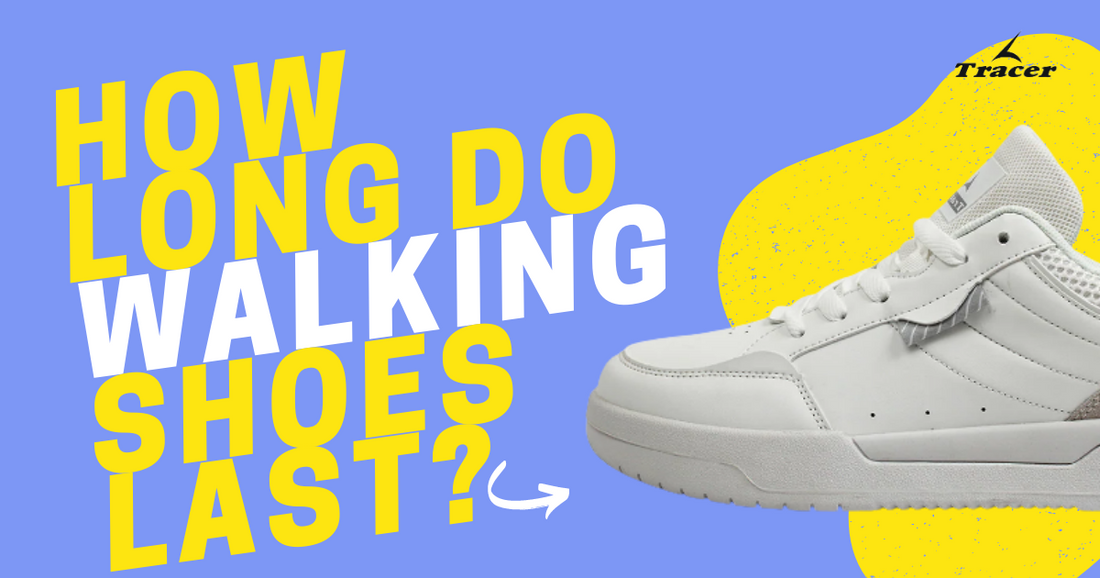Read Time - 6 Min
Have you ever seen an expiry date on a shoe box before? Most likely not! That doesn't imply they live indefinitely. So, how long are shoes good for? There is no simple answer to this question. Therefore, we sought to explain why and how shoes degrade and how you should care for your shoes to last longer.
Maybe you thought your shoes were perfectly safe the last time you saw them in your gym bag. Maybe it's time to let them out of quarantine and take them on a stroll to check whether they're still alive. You probably have to say goodbye to those old shoes and pray for their "sole" to rest in peace.

The Outsole, Midsole And Upper
Before we get into how and why shoes deteriorate, let's go through the three primary components of a shoe: the outsole, midsole, and upper.

The outsole is the bottom section of your shoe that is often composed of rubber. The midsole is the soft foam layer that sits between the outsole and the upper. Because of the shock-absorbing qualities, they are the most significant aspect of a walking shoe. A good midsole protects your feet while also providing a bouncy feel when walking. The upper is the outer-top component of the shoe above the insole that is generally composed of mesh materials to enhance breathability. These three parts are kept together by glue or a row of thread sewing.

How Does An Unworn Shoe Degrade?
The harsh reality is that your shoes will die whether you wear them or not. It does not imply that unworn shoes will deteriorate at the same pace as regularly used shoes, but it does mean that they will not survive as long as a new pair.

Technically, a shoe is supposed to last for 700 to 800 kilometres. However, old unworn shoes may only last for 300 to 400 kilometres. You might still be able to get 700 to 800 kilometres out of an older, unworn shoe, but the chances of harming your feet are high as the materials have already begun to degrade.
While shoes may not deteriorate soon after being manufactured, it is better to get a pair that has not been on the store shelves for more than three months. That's why many manufacturers advocate wearing a new pair of shoes for only 6 to 12 months after purchasing them.
Unfortunately, both the outsole (rubber) and the midsole (foam) wear down with time. The outsole and the midsole start to break down even on unworn shoes. As time passes by, they lose their cushioning as the foam begins to splinter from the inside.
However, rubber and foam aren't the only materials that degrade. Even when these components are merely lying on a shelf, the glue that holds them together degrades with time. The thread can get slack at times, especially at the edges. The upper is more prone to fail since the glue or thread joins the sole and the upper.
Now that you've understood that even unworn shoe age over time, let's take a look at how long a pair of walking shoes you use daily will last.

How Long Your Everyday Walking Shoe Will Last?
If you think that visible wear and tear on the shoe is the only indication that your shoes have expired, then you are most likely deceived by looks.
To know how long your regularly-used walking shoe will last, take a sneak peek at their midsole first. As previously said, the midsole is the most significant aspect of your shoe; a broken midsole will absorb shocks inadequately and immediately risk the protection of your feet. If you don't experience the same comfort you had when you first got them, or if you notice any tension on your feet when walking, it's time to say goodbye to those shoes.
The second thing you should look for is the rubber outsoles. After six months of constant usage, they are readily susceptible. The rubber outsoles' endurance is mainly reliant on the surface you walk on. The rubber outsoles might be damaged if they are subjected to harsh surfaces regularly. This further damages the form of the lugs, resulting in a loss of traction or grip on the ground. By placing them on a level surface, you can see if the heel has worn down more on one side than the other. If the shoe leans to one side, it indicates that the heel has worn out.
Form friction in the heel and toe box locations causes the upper mesh to tear. When shoes are overused, tiny holes in the top mesh appear, and these little holes eventually expand into larger ones, tearing the shoe completely. Your weight is another issue that may cause your shoes to wear out faster. The more you weigh, the quicker your shoes will wear out.

What Are The Downside Of Wearing Old Shoes?
Your old walking shoes are dead because they no longer provide enough support and cushioning. Because there is no padding, your feet must absorb a heavier pounding with each stride. Thus, inadequate cushioning causes foot, knee, and leg discomfort, as well as disorders such as iliotibial band syndrome and plantar fasciitis. To avoid these issues, check for indicators of a dead shoe and replace it before it affects your feet.
Keep an eye out for the indicators listed below to determine if your shoes are healthy for your foot or not.
- Lack of cushioning, or it no longer feels as comfortable as it once did.
- Experiencing unexpected foot fatigue.
- The thickness of the midsole has been reduced significantly due to compression in the midsole.
- Deterioration of the shoe's outsole, midsole, or upper.
- Lack of walking support.
- Poor traction or grip, even on flat ground.
- Walking with insufficient stability or sturdiness.
- Your feet keep sliding around the heel area.
- The shoe has either gotten too big or too small.
- Interior heel surface degradation.
How to properly maintain your walking shoes to make them last longer?
- First and foremost, save a pair of walking shoes just for fitness walks. Wearing your walking shoes all day may damage them owing to prolonged exposure to foot sweat and bacteria.
- Before storing them, use a disinfectant spray and thoroughly dry them. Air out your shoes after each wear. Store them in an open space and avoid storing them in your gym bag or inside any closed shoe box.
- Follow the manufacturer's washing directions. If there are no cleaning instructions, use a mild soap and cold water to clean your shoes.
- Too much heat may quickly break down the adhesive in your shoe so take care not to break the glue. It is better to air dry your walking shoes instead of tossing them in the dryer.
- It is a good idea to track how often you wear them and the condition of your road or walking route.
Here's a rule of thumb to help you determine whether it's time to replace your old walking shoes. If you walk for half an hour, three to four times a week, you should replace your shoes every six months. If you walk more than 7 hours per week, you should replace your shoes every three to four months. Write the date on the arch of the outsole using a permanent marker, so you don't have to wonder when to replace your shoe if you can’t recall when you bought it.
Even though sneakers look great with any attire and appear suitable for most outdoor activities, they are not the ideal shoes for fitness walking. If you walk for more than 30 minutes every day, a walking shoe or any athletic shoe with qualities similar to a walking shoe will be your safest option, as wearing casual sneakers will cause knee pain from walking too much.
Does Walking Reduce Belly Fat?
Fitness walking, unlike regular walking, is a full-body workout that is excellent for improving your entire health and well-being. According to studies, 30 minutes of frequent brisk walking will help you lose belly fat and shrink your waistline. Walking for fitness is a terrific form of physical activity that is simple, risk-free, and an excellent method to burn fat and stay fit. Fitness walking is one of the simplest types of exercise that you can add to your daily routine.
Walking is good for your health, and so is a decent pair of walking shoes to keep your feet healthy and safe. If you are looking for shoes that last long, look no further!

Victory 1551 by Tracer India is a stylish walking shoe available at an unimaginably reasonable price. Victory 1551 is well ahead of the competition for the five fundamental attributes of a walking shoe (shock absorption, fit, traction, breathability, and light wear). The lacing system will aid you in adjusting the shoes to your liking and secure your feet against heel slippage. Victory 1551 will undoubtedly be one of the shoes that last long in your collection. If you're looking for a long-lasting and reasonable pair of shoes, then Victory 1551 is definitely a steal.
FAQ
Q1. Does walking wear out shoes?
Walkers may experience more wear and tear in the heel area due to their landing style. For optimal performance and comfort, it is recommended to replace walking shoes every three to five months, especially if walking for 45 minutes at least three times a week. Regular replacements ensure continued support and prevent discomfort during your walking routine.
Q2. How can you tell when you need new walking shoes?
Signs you need new walking shoes:
1. Worn-out tread patterns
2. Visible creases or cracks in the midsole
3. Decreased cushioning and support
4. Discomfort or pain during walking
5. Uneven wear on the outsole or sides
6. Shoes losing their original shape
7. Reduced water resistance
8. Listen to your body for any discomfort or fatigue.
Q3. How often should you replace your shoes?
The frequency of replacing your shoes depends on factors like usage, walking habits, and shoe quality. As a general guideline:
- Running Shoes: Every 300-500 miles (or 3-6 months for regular runners).
- Walking Shoes: Every 300-500 miles or when signs of wear and tear appear.
- Everyday Shoes: Every 6-12 months, depending on usage and shoe quality.
- Athletic Shoes: Every 6-12 months for regular athletes or gym-goers.


